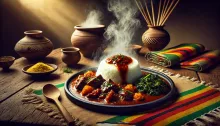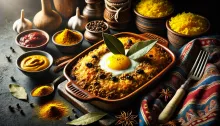Chorba is a cherished North African soup, known for its warming, spicy broth and nourishing ingredients. It's a staple during Ramadan and cold months, offering both comfort and sustenance.
Historical Roots and Significance With roots in Ottoman cuisine, Chorba has been localized in Maghreb countries, particularly Algeria and Tunisia. It holds a special place in iftar meals during Ramadan, believed to gently reintroduce food after long fasting hours.
Ingredients
- Lamb or beef
- Tomatoes, onions, garlic
- Vermicelli or occasionally rice
- Chickpeas
- Spices: turmeric, cinnamon, black pepper, paprika
- Fresh herbs like parsley and coriander
How It’s Made Lamb is browned in oil with onions and garlic, followed by chopped tomatoes and spices. Water is added, and chickpeas simmer until tender. Vermicelli is added last to prevent overcooking. A final garnish of herbs brings freshness.
Taste Profile Chorba balances spiciness with aromatic herbs. The tomato base provides a tangy sweetness, while the chickpeas and lamb add body. Vermicelli makes it more filling and absorbent of flavors.
Cultural Variants Tunisian versions tend to be spicier and may include harissa. Algerians may use more cinnamon and often add celery or carrots. Some households use beef or even chicken as substitutes.
Nutrition and Benefits This dish is protein-rich and hydrating. The chickpeas contribute fiber and plant protein, while the tomato broth aids digestion. It’s ideal for fasting due to its balance of nutrients.
Modern Adaptations Vegetarians often make it with lentils and vegetable broth. Instant pot versions and fusion styles using pasta or quinoa have also emerged.
Conclusion Chorba is more than a soup; it's a culinary hug from North Africa. Whether at a family dinner or breaking fast during Ramadan, it delivers both nourishment and nostalgic warmth.


